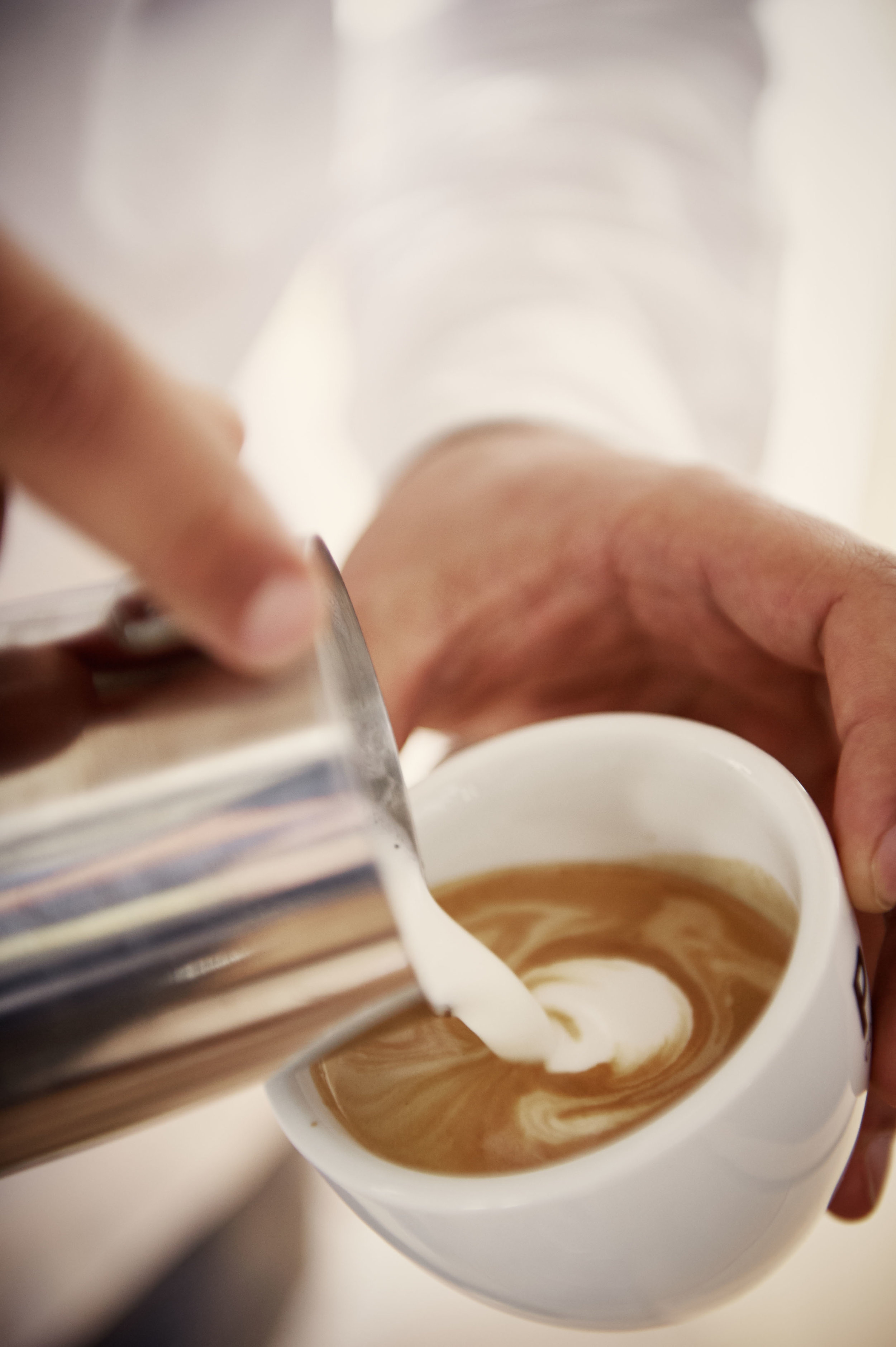Hamburg`s Best Coffee Shops - Public Coffee Roasters
.... Coffee Afloat .. Ente, Ente, Ente, Ente, Ente ....
Text: Michaela Kompala
....
Coffee on the Water
Let's be honest, people from Hamburg are not exactly spoiled when it comes to beautifully warm sunshine on their skin. When the great golden orb surprises us in the morning, we locals drop everything, grab our sunglasses and are off to the outdoors.
It’s a day like that today so I hop on my bicycle to pamper myself with healthy things: fresh air, vitamin D and, of course, caffeine. There couldn't be a nicer route, nor a nicer place to drink (a) coffee and learn something.
This place is called Entenwerder, next to the river Elbe. It's in the middle of the city but still manages to have the beauty of an idyllic country scene. It is there, not next to but actually on the water, their I meet Argin and Arameh. They are the brains behind the Public Coffee Roasters. In 2016 Argin and Arahmeh stared meeting here with their team, in this tiny house, built on a pontoon on the river Elbe, to develop their own concept of coffee.
After I was treated to two tasty flat whites and pestered Argin with some questions about Public, Sevak begins to roast the first coffee. From the beginning right to the end, Argin and his team strive to create the highest quality. The coffee beans must pass countless exams before they are allowed into the big roaster. They also only allow select coffee plantations to send them samples to be tested for their quality and taste in the small sample roaster. These beans are exclusively Arabica beans, known for their refined taste and top quality. Arabica is one of many varieties of coffee plants. They grow in higher altitudes, generally from 1400m above sea level, and it is by virtue of this that Arabica has such a refined taste.
..
Sind wir mal ehrlich. Wir Hamburger sind nicht so verwöhnt was den Genuss von warmen, kräftigen Sonnenstrahlen auf der Haut angeht. Aber wenn wir morgens aufstehen und sie sehen, die große goldene Kugel, lassen wir Hanseaten alles stehen und liegen, setzen die Sonnenbrille auf und ab gehts ins Grüne.
Heute ist so ein Tag und ich schwinge mich auf mein Rad um meinen Körper mit den gesunden Dingen zu verwöhnen: Frischer Luft, Vitamin D und Koffein natürlich. Es könnte keine schönere Strecke und keinen schöneren Ort geben um Kaffee zu trinken und was zu lernen.
Entenwerder heißt das Plätzchen an der Elbe, das mitten in der Stadt liegt aber trotzdem die Schönheit einer ländlichen Idylle hat. Dort, nicht am Wasser, sondern auf dem Wasser, treffe ich mich mit Argin und Arameh, den Köpfen hinter den Public Coffee Roasters. In einem kleinen Häuschen auf einem Ponton haben die beiden sich seit 2016 mit ihrem Team eingenistet um ihre Vorstellung von Kaffee umzusetzen.
Nachdem ich nun zwei leckere Flatwhite genießen durfte und Argin mit Fragen über den Start von Public gelöchert habe, fängt Sevak an den ersten Kaffee zu rösten. Von Anfang bis Ende achten Argin und sein Team auf höchste Qualität. Bevor die Kaffeebohnen in den großen Röster dürfen, haben Sie schon jede Menge Prüfungen hinter sich. Nur von ausgewählten Kaffeeplantagen lassen sie sich Proben nach Hamburg schicken und testen im kleinen Probenröster Qualität und Geschmack. Diese Bohnen sind ausschließlich Arabicabohnen, welche bekannt für den feinen Geschmack und beste Qualität sind. Arabicabohnen sind eine von vielen Varietäten von Kaffeepflanzen und sie wachsen in höheren Regionen, in der Regel ab 1400m über Null und entwickeln aufgrund dessen feineren Geschmack.
....
....
And now it's getting hot in here, for the beans to develop their full aroma evenly, the still green coffee beans are roasted in a rotating drum at around 200° for 11-14 minutes.
The entire process is remotely controlled by a computer that follows a roasting profile, previously made by the Public family. As a matter of fact, the Public Coffee Roasters are a family run business, the man at the roaster is Argin's uncle Sevak and Argin even brought his brother Ahameh in. Although the other team members aren't blood relatives, they are still part of the big coffee family. But more about that another time.
..
Aber jetzt gehts heiß her, bei etwa 200 ° werden die noch grünen Kaffeebohnen 11-14 Minuten lang in einer Trommel geschwenkt, damit alle Bohnen gleichmäßig ihr volles Aroma entwickeln.
Gesteuert wird der ganze Prozess von einem Computer, auf dem ein zuvor von der Public Familie erstelltes Röstprofil verfolgt wird. Und tatsächlich sind die Public Coffee Roasters ein Familienunternehmen, der Mann am Röster ist Argins Onkel Sevak und auch seinen Bruder Arameh hat Argin ins Boot geholt, auch wenn die weiteren Teammitglieder von Public nicht blutsverwandt sind, werden alle dort in die große Kaffeefamilie aufgenommen. Aber dazu ein andern mal mehr.
....
....
The shorter you roast a coffee bean, the fruitier the coffee will taste, explains Argin, but it also makes the coffee more sour, because with time in the roaster, the acidity breaks down further. And then I hear it cracking! The coffee beans havereached the “first crack” stage. The heat makes the residual moisture evaporate and the cells burst open.This chemical process also makes the beans larger. The second crack happens soon after and then there's no time to lose: The beans need to be taken off the heat. Studying his profile, the roast master decides when the beans are taken out of the roaster; any time between the first and second crack is a possibility, and every second is important to the aroma of the coffee! It is so exciting, Ihave to drink another espresso after all that excitement.
I wonder if there are people who don't like the scent of coffee. But I can promise you this: The scent of freshly roasted coffee blows anyone away! I can't remember ever having smelled anything that touched my soul in quite the same way. It is the perfect blend of a light chocolate scent and the smell of a darkly baked bread. The blend of sweet and savoury is the most surprising and at the same time most perfect thing my nose has ever experienced … but I'm going off on a tangent!
..
Je kürzer eine Kaffeebohne geröstet wird desto fruchtiger wird sie im Geschmack, erklärt mir Argin, aber desto mehr Säure enthält der Kaffee auch, weil mit der Zeit im Röster die Säure abgebaut wird. Und dann hör ich ein knacken! Die Bohnen im Röster haben den “First Crack” erreicht. Durch die Hitze verdampft die restliche Feuchtigkeit und die Zellen platzen auf, was auch dazu führt, dass die Bohnen größer sind nach diesem chemischen Prozess. Kurz darauf erfolgt der zweite Crack und dann heißt es allerhöchste Eisenbahn und ab aus der Hitze für die Bohnen. Der Röstmeister entscheidet mit seinem Profil darüber wann er die Bohnen aus dem Röster holt, alles zwischen dem ersten und zweiten Crack ist möglich und jede Sekunde ist von Bedeutung für das Aroma des Kaffees! Das ist so spannend, darauf muss ich gleich noch einen Espresso trinken!
Ich frage mich derweil ob es Menschen gibt, die den Duft von Kaffee nicht mögen. Aber eins verspreche ich euch, der Duft von frisch geröstetem Kaffee überzeugt jeden! Ich kann mich nicht daran erinnern jemals etwas erschnuppert zu haben, dass meine Seele mehr berührt hat. Es ist die perfekte Mischung aus einer leichten Schokoladen-Note und dem herben Duft eines braun geröstetem Brot. Diese Mischung aus süß und herb ist das Unerwarteste und gleichzeitig Vollkommenste was meine Nase jemals erfahren hat … Aber ich schweife ab!
....
....
Sevak let's the freshly roasted beans cool before they are packaged, and straight away the next batch of coffee beans goes into the roaster.
In comparison to industrial roasts, Public's roasting temperature is very low. The beans are often roasted at around 600° for only 4 – 6 minutes. This leads to the beans being black on the outside but still green on the inside.
..
Sevak lässt nun die frisch gerösteten Bohnen noch abkühlen bevor sie abgefüllt werden und gleich im Anschluss kommt die nächste Charge Bohnen in den Röster.
Die Rösttemperatur ist übrigens im Vergleich zu industriellen Röstungen sehr gering, dort werden die Bohnen nämlich bei etwa 600° nur 4 – 6 Minuten lang geröstet. Das führt dazu, dass die Bohne außen nahezu schwarz ist und Innen noch grün.
....
.... THIS IS A BLOW TO THE TASTE OF COFFEE AND THE STOMACH OF COFFEE JUNKIES .. Das schlägt auf den Geschmack des Kaffees und auf den Magen vom Kaffeejunkie ....
....
I can't detect the familiar “burnt” taste of German coffee in any of Public's coffee. Instead I taste many strong flavours, fruity variety and attention to detail. That makes me want to enjoy another cup or two of liquid luck. And nothing stops me as I don't need to worry about my belly for everything here is roasted gently."
This is where I stay for the rest of the day, sitting in the sun… Towards the end of the day, the coffee is substituted for a gin and tonic and the summer in Hamburg is over. Everyone knows it only lasts for one day.
I certainly did it right. ;)
..
Den in Deutschland bekannten “verbrannten” Geschmack von Kaffee kann ich nicht in den Kaffees von Public finden. Stattdessen viele kräftige Aromen, fruchtige Vielfalt und Liebe zum Detail. Und darum lass ich mir noch einige Portionen Glück in der Tasse schmecken. Sorgen um meinen Bauch muss ich mir ja nicht machen, schließlich ist hier alles schonend geröstet.
Hier bleib ich für den Rest des Tages, sitze in der Sonne… gegen Abend wird der Kaffee durch einen Gin Tonic ersetzt und fertig ist der Sommer in Hamburg. Der dauert in Hamburg ja bekanntlich auch nur einen Tag.
Also alles richtig gemacht. ;)
....




















